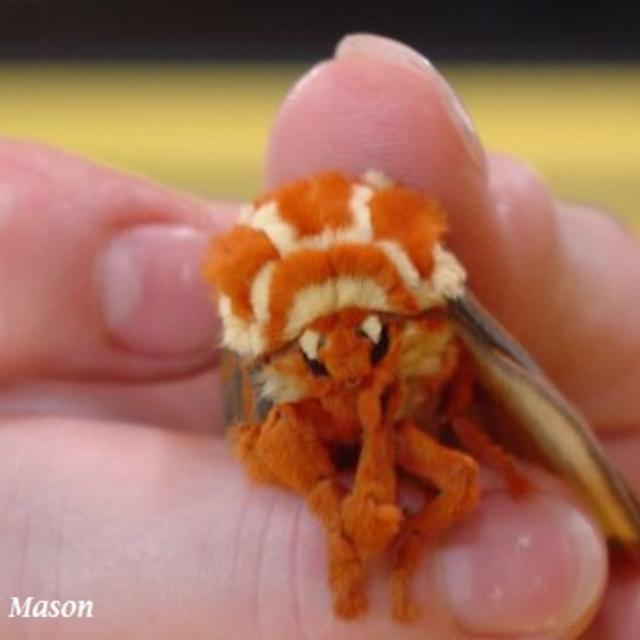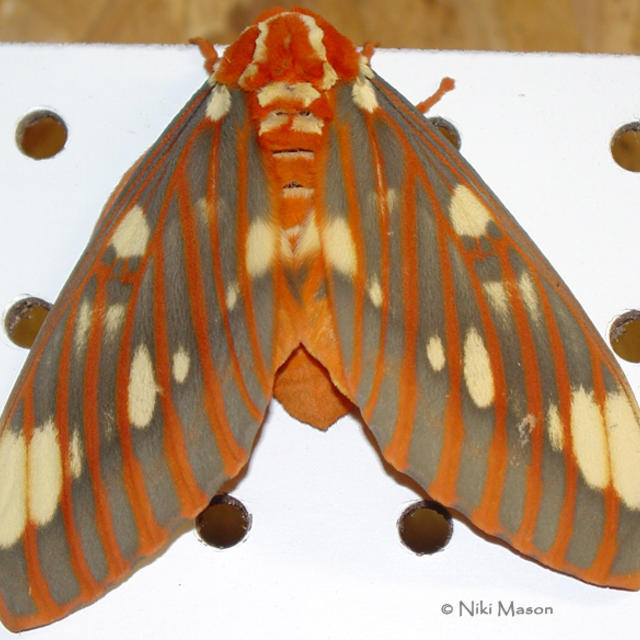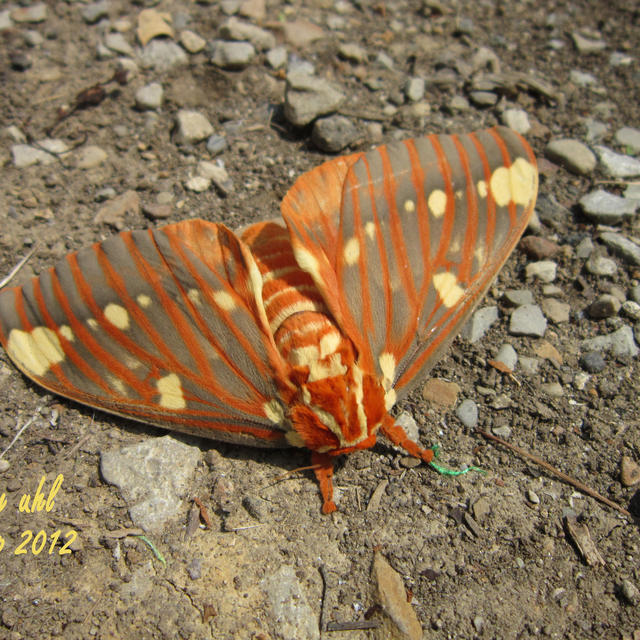Royal Walnut Moth
Citheronia regalis (Fabricius, 1793)
Family: Saturniidae
Subfamily: Ceratocampinae
Identification: Females are larger than males. Upperside of forewing is gray with red-orange veins and creamy yellow spots. Upperside of hindwing is orange with creamy yellow at the costa and inner margin.
Wing Span: 3 15/16 - 6 1/4 inches (10 - 16 cm).
Life History: Adults emerge in late evening and mate the following evening. Females begin laying eggs at dusk the next day, depositing them in groups of 1-3 on both sides of host plant leaves. Eggs hatch within 6-10 days, and the caterpillars (known as the Hickory Horned Devil) feed alone. Young caterpillars rest on the tops of leaves and resemble bird droppings, while older caterpillars appear menacing because they are very large and brightly colored with red "horns" near the head. Caterpillars pupate in a burrow in the soil.
Flight: One brood from May through mid-September.
Caterpillar Hosts: Hickories (Carya), pecan (C. illinoensis), butternut (Juglans cinerea), black walnut (J. nigra), sweet gum (Liquidambar styraciflua), persimmon (Diospyros virginiana), sumacs (Rhus), cultivated cotton (Gossypium), and others.
Adult Food: Adults do not feed.
Habitat: Deciduous woods.
Range: New York west through southern Michigan and Illinois to eastern Kansas; south to central Florida, the Gulf states, and east Texas.
Conservation: Not usually required.
NCGR: G5 - Demonstrably secure globally, though it may be quite rare in parts of its range, especially at the periphery.
Management Needs: None reported.
Get your BAMONA Gear!
Please donate!
We depend on donations to keep Butterflies and Moths of North America freely available. We want to express our gratitude to all who showed their support by making a contribution this year. You can donate to support this project at any time.
Advertise with us!
Do you have a product or service that you think would interest BAMONA users? If you would like to advertise on this website, contact us by email, or use the contact form and select the "Advertising" category.
Verified Sightings
Displaying 1 - 24 of 1059 verified sightings

Observation date: Jul 12, 2024
Submitted by: Jbanks
Region: Cullman County, Alabama, United States
Verified by: stomlins701
Verified date: Sep 05, 2024

Observation date: Jul 24, 2024
Submitted by: pecheur5
Region: Maryland, United States
Verified by: jwileyrains
Verified date: Jul 25, 2024

Observation date: Jul 20, 2024
Submitted by: MWatkins2000
Region: Nelson County, Kentucky, United States
Verified by: rogerdowner
Verified date: Jul 22, 2024

Observation date: Jul 16, 2024
Submitted by: scissorfingers
Region: Braxton County, West Virginia, United States
Verified by: curtis.lehman
Verified date: Jul 16, 2024

Observation date: Jul 15, 2024
Submitted by: Jbramble9756
Region: Scott County, Tennessee, United States
Verified by: rogerdowner
Verified date: Jul 15, 2024

Observation date: Jul 13, 2024
Submitted by: pgladstone
Region: Buncombe County, North Carolina, United States
Verified by: rogerdowner
Verified date: Jul 15, 2024

Observation date: Jul 10, 2024
Submitted by: Kegler777
Region: Stokes County, North Carolina, United States
Verified by: rogerdowner
Verified date: Jul 13, 2024

Observation date: Jul 10, 2024
Submitted by: Les in Ohio
Region: Guernsey County, Ohio, United States
Verified by: rogerdowner
Verified date: Jul 11, 2024

Observation date: Jul 09, 2024
Submitted by: Steven Wilson
Region: Nicholas County, West Virginia, United States
Verified by: curtis.lehman
Verified date: Jul 09, 2024

Observation date: Jul 09, 2024
Submitted by: Rclements7051
Region: Lexington County, South Carolina, United States
Verified by: Dennis Forsythe
Verified date: Jul 09, 2024

Observation date: Jul 07, 2024
Submitted by: Hannabert
Region: Dickson County, Tennessee, United States
Verified by: rogerdowner
Verified date: Jul 07, 2024

Observation date: Jun 28, 2024
Submitted by: ArtistEclectic
Region: Talladega County, Alabama, United States
Verified by: stomlins701
Verified date: Jul 02, 2024

Observation date: Jul 01, 2024
Submitted by: Jacqulin phares
Region: Greenville County, South Carolina, United States
Verified by: Dennis Forsythe
Verified date: Jul 01, 2024

Observation date: May 17, 2024
Submitted by: Diogenes1962
Region: Lauderdale County, Alabama, United States
Verified by: stomlins701
Verified date: May 18, 2024

Observation date: Jul 26, 2019
Submitted by: dahlia
Region: Meade County, Kentucky, United States
Verified by: rogerdowner
Verified date: Jan 13, 2024

Observation date: Sep 02, 2023
Submitted by: ELFredrickson
Region: Madison County, Kentucky, United States
Verified by: CA Ivy
Verified date: Sep 03, 2023

Observation date: Aug 14, 2023
Submitted by: My Own KY Woods
Region: Boyd County, Kentucky, United States
Verified by: rogerdowner
Verified date: Aug 14, 2023

Observation date: Aug 05, 2023
Submitted by: AndreainOhio
Region: Muskingum County, Ohio, United States
Verified by: rogerdowner
Verified date: Aug 06, 2023

Observation date: Jul 26, 2023
Submitted by: AGinter
Region: Knox County, Ohio, United States
Verified by: rogerdowner
Verified date: Jul 29, 2023

Observation date: Jul 26, 2023
Submitted by: snailsnshrooms
Region: Cherokee County, Georgia, United States
Verified by: Mikelchap
Verified date: Jul 28, 2023

Observation date: Jul 26, 2023
Submitted by: BertyBecky16
Region: Wood County, West Virginia, United States
Verified by: curtis.lehman
Verified date: Jul 27, 2023

Observation date: Jul 25, 2023
Submitted by: turtlefoot
Region: Howell County, Missouri, United States
Verified by: jamesdurbin
Verified date: Jul 27, 2023

Observation date: Jul 25, 2023
Submitted by: Saswango
Region: Ohio County, Indiana, United States
Verified by: rogerdowner
Verified date: Jul 25, 2023

Observation date: Jul 23, 2023
Submitted by: Tommie Rogers
Region: Marion County, Tennessee, United States
Verified by: rogerdowner
Verified date: Jul 23, 2023
- 1 of 45
- next ›

















